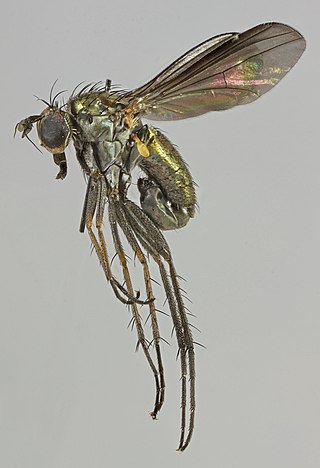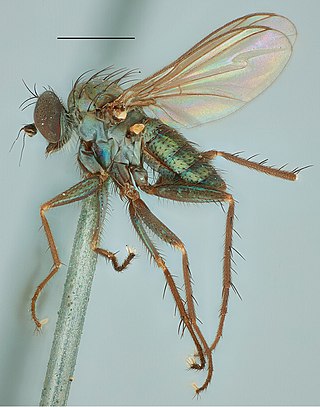Oedematopus is a genus of flies in family Dolichopodidae.

Hercostomus is a genus of flies in the family Dolichopodidae. It is a large genus, containing more than 483 species worldwide. Multiple studies have shown that Hercostomus is a polyphyletic assemblage of species.
Anasyntormon is a genus of flies in the family Dolichopodidae. It was originally placed in the subfamily Rhaphiinae near Syntormon. It was transferred to Dolichopodinae by Hans Ulrich (1980), who found it to be congeneric or closely related to Hercostomus.
Antyx is a genus of flies in the family Dolichopodidae from the Australasian realm. The genus was originally placed in the subfamily Sympycninae, but it was later found to be closer to the Neurigoninae and was placed as incertae sedis within the family. In the World Catalog of Dolichopodidae by Yang et al. (2006), the new subfamily Antyxinae was proposed, in which Antyx is the only genus. However, the validity of this new subfamily was later criticized by Sinclair et al. (2008). According to them, the subfamily's erection by Yang et al. (2006) was not justified by their phylogenetic analysis, and the genus would have been better placed as incertae sedis until a later phylogenetic study determines its placement.
Argyrochlamys is a genus of flies in the family Dolichopodidae. It is known from the Afrotropics, the Oriental realm, and the southernmost part of the Palearctic realm.

Asyndetus is a genus of flies in the family Dolichopodidae. There are more than 100 species described for the genus, distributed worldwide.
Katangaia is an African genus of flies in the family Dolichopodidae. It was originally placed in the subfamily Rhaphiinae, though it was later transferred to Dolichopodinae. In 2005, based on a cladistic analysis of the subfamily, Scott E. Brooks excluded Katangaia from the Dolichopodinae. However, later authors have retained the genus in this subfamily.

Lichtwardtia is a genus of flies in the family Dolichopodidae. In a phylogenetic analysis of the subfamily Dolichopodidae by Scott E. Brooks in 2005, Lichtwardtia is considered to be a synonym of Dolichopus, but other authors retain it as a valid genus. Before this, it was considered a possible subgenus of Pterostylus by Oleg Negrobov (1979).

Sybistroma is a genus of flies in the family Dolichopodidae. It includes over 50 species, described mainly from the Palaearctic and Oriental realms. A single species is known from the Afrotropical realm. Until 2005, the genus was thought to be restricted to the Mediterranean in distribution, with five known species. It was recently expanded to include the former genera Hypophyllus, Ludovicius and Nordicornis, as well as some species of Hercostomus.

Dolichopodinae is a subfamily of flies in the family Dolichopodidae.
Kowmunginae is a subfamily of flies in the family Dolichopodidae. It was proposed in the World Catalog of Dolichopodidae by Yang et al. (2006) to include two genera previously placed as incertae sedis within the family. However, the validity of this new subfamily was later criticized by Sinclair et al. (2008). According to them, the subfamily's erection by Yang et al. (2006) was not justified by their phylogenetic analysis, and the genera included would have been better placed as incertae sedis until a later phylogenetic study determines their placement.

Parathalassiinae is a subfamily of flies in the family Dolichopodidae. It is part of an extended concept of the family, Dolichopodidae sensu lato, and forms a monophyletic group with Dolichopodidae sensu stricto. It was once placed provisionally in the subfamily Microphorinae as the tribe Parathalassiini.
Chimerothalassius is a genus of flies in the family Dolichopodidae. It contains five described species, two from New Zealand, two from New Caledonia and one from the Caribbean. It also contains three undescribed species, two from New Zealand and one from Costa Rica.

Microphorinae is a subfamily of flies in the family Dolichopodidae. It is part of an expanded concept of the family, Dolichopodidae sensu lato, though it was previously considered a family of its own.
Avenaphora is an extinct genus of flies in the family Dolichopodidae. It is known from the Cretaceous of Lebanon and France.
Microphorites is an extinct genus of flies in the family Dolichopodidae.

Microphor is a genus of flies in the family Dolichopodidae, subfamily Microphorinae.
Griphophanes is a genus of flies in the family Dolichopodidae. It is known from Southeast Asia and the Democratic Republic of the Congo in Central Africa.
Schistostoma is a genus of flies in the family Dolichopodidae, subfamily Microphorinae.






